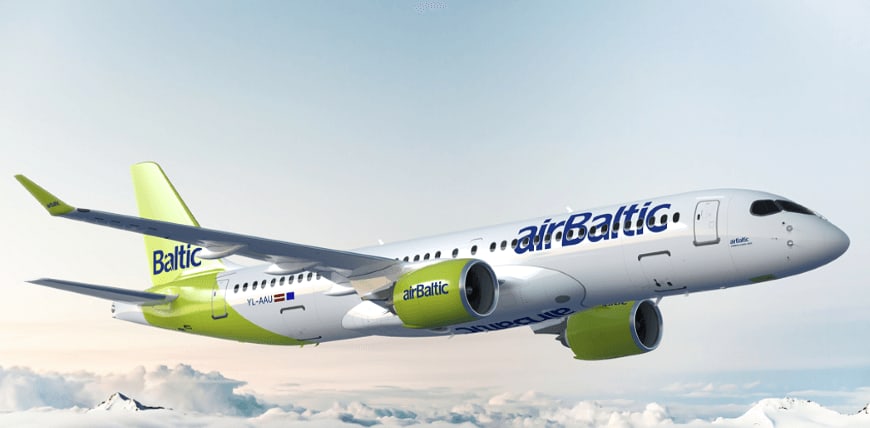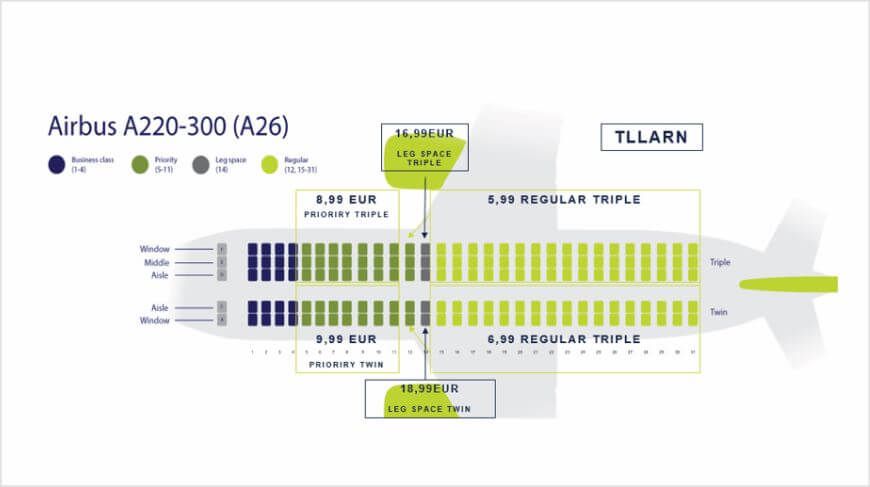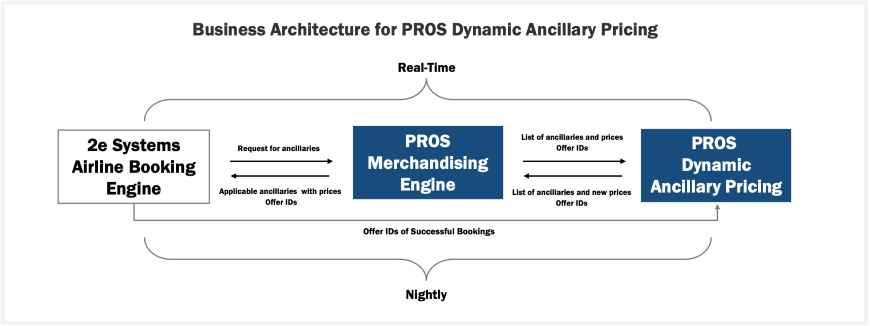The customer
airBaltic is the leading airline in the Baltics. For 3 decades the airline has been connecting the Baltics with more than 70 destinations in Europe, the Middle East, North Africa, and the Caucasus region, today serving more than 130 routes from 5 bases.

To support its growth vision airBaltic is investing in innovation across the board: from modern single-type Airbus A220-300 fleet, to the latest technology advancements in eCommerce to drive revenue optimization. The carrier is an avid AI-adopter, consistently integrating various AI capabilities to enhance efficiency and optimize operations.
Most recently airBaltic was awarded with PROS AI Innovator Award 2024 for the successful implementation of PROS AI-powered Dynamic Ancillary Pricing (DAP) solution that the airline uses to automate and optimize the pricing of seat assignments.
 |
Eva Plakane
SVP Revenue Management  |
Challenge
For more than a decade airBaltic has been doing airline-led offer creation using PROS Offer Creation and Retailing solutions (PROS Shopping and PROS Merchandising). Today, the leading airline in the Baltics is managing their entire fare and ancillary catalog in real-time and customizing offers based on granular customer segmentation.
Having a robust price differentiation strategy allows the airline to utilize dynamic pricing techniques for their ancillary products and services. airBaltic’s eCommerce team had already seen remarkable results with seat assignment pricing being personalized based on channel and product characteristics. However, pricing remained static and non-differentiated for different passengers, markets, or routes.

airBaltic Airbus seat map configuration
Driven by the success of their merchandising strategy, the airline’s eCommerce team believed that there is still potential to manage seat assignment revenue better and take their pricing strategy to the next level. In addition, these sophisticated pricing business rules also required dedicated manual efforts from the team to create, update, and maintain.
Three key objectives led airBaltic’s decision to opt in for Artificial Intelligence:
- Revenue generation: By adopting AI, the team targeted achieving optimal prices that convert better and could drive another 2-3% revenue increase per passenger, which proved to be a conservative expectation.
- Automation: With the introduction of AI, the airline was looking for more workflow automation to free them up from the repetitive tasks and help avoid any sporadic human errors.
- Competitiveness: By leveraging AI capabilities, airBaltic was aiming at gaining a competitive edge to stay ahead of the market.
Solution & Implementation
 |
Iuliia Granja Velasco
eCommerce Project Manager  |
The AI-powered approach for ancillary optimization was planned for seat assignment pricing. airBaltic embarked on a phased approach to adopting PROS Dynamic Ancillary Pricing: an independent stand-alone solution that would integrate in the airline’s IT retail ecosystem and liaise with the internet booking engine (IBE) provided by 2e Systems and the merchandising engine provided by PROS in a continuous offer optimization flow.
The airBaltic eCommerce team worked closely with the airline’s ancillary revenue management team to define the goals for the DAP project against which to be able to measure the results: revenue generation and business-rule automation, granting the airline a more competitive position on the market.
Watch the video to learn about the phases of airBaltic’s implementation of PROS DAP.
Phase 1: Preparation – 1 ½ months
During the Preparation phase the airBaltic team worked closely with the PROS team to define the segmentation criteria that would drive the recommendations for seat assignment pricing. 15+ dimensions were set to determine price differentiation and match customer willingness-to-pay.
PROS DAP solution, being fully standalone and agnostic, can integrate with any merchandising tool to deliver AI-powered pricing. However, an accelerator for the project was the fact that the airline’s merchandising engine, powered by PROS, was already integrated with PROS Dynamic Ancillary Pricing solution, ensuring seamless access to airBaltic’s ancillary catalog and seat map, as well as access to business rules setup, base prices and price conditions.

PROS DAP integration with PROS Merchandising and airBaltic’s IBE
The airline also collaborated on the technical integration of their IBE provider 2e Systems to ensure a data flow between airBaltic.com and PROS Dynamic Ancillary Pricing is built to deliver information about successful seat bookings. This information lies at the heart of training the DAP AI models to deliver pricing based on demand and customer preferences.
Phase 2: Go-live, Learning and Adjustment – 2 ½ months
The second phase started with the go-live of the AI-powered seat pricing on airBaltic.com and included daily monitoring of the prices PROS DAP was delivering to customers. The airline’s team focused on observing how the AI model was learning and adjusting.
PROS DAP AI-model leverages reinforcement learning to continuously learn over time, using win-loss data on conversion rates. It uses efficient exploration through Thompson Sampling approach to optimize the price exploration process, so that reaching an optimal price point takes less effort and time, leading to quicker time-to-value. At the same time price guardrails are in place, making sure dynamicity in pricing is kept intact within same day requests, and customers are always offered consistent prices, regardless of any system abuse attempts.
Phase 3: A/B Testing – 2 months
The last phase of the implementation began as airBaltic started A/B testing on their dotcom channel. The goal was to compare the prices generated by PROS Dynamic Ancillary Pricing solution against the rules-based prices predefined in the merchandising system. For that purpose, the website traffic on airBaltic.com was split in two. The eCommerce team also monitored how revenue per passenger was performing against previous periods to evaluate the revenue impact of the AI-driven approach.
Results
It took only two months for the airBaltic eCommerce team to draw the conclusion that PROS DAP was driving 6% ASR* revenue increase per passenger, which surpassed the initial project goals of 2-3%.
 |
Jolanta Rema
VP eCommerce and Commercial Distribution  |
*ASR: Advanced Seat Reservation
In addition to the promising revenue uplift, the airline today benefits from:
- Seat assignment pricing that is driven by demand and customer preferences. Each dynamically generated price is tailored to a specific customer segment and reflects a unique combination or traveler, trip, and product features.
- High degree of automation: The airline also achieved its efficiency goal, reducing manual efforts to almost zero. The reinforcement learning feature of PROS Dynamic Ancillary Pricing allows pricing errors to be fixed by the AI model automatically, liberating the eCommerce team to focus on more strategic tasks.
- Increased competitiveness: This industry-first approach to abandon static ancillary pricing and price offers in real-time sets airBaltic apart from its competitors as a first-mover, leading the market with AI-fueled innovation.
Learn more about PROS Dynamic Ancillary Pricing and PROS Merchandising solutions on PROS Marketplace.
Frequently Asked Questions
Dynamic ancillary pricing uses AI to adjust prices for airline add-ons, such as seat assignments, in real-time. It tailors prices based on customer demand, preferences, and market conditions to boost revenue.
airBaltic achieved a 6% increase in seat revenue per passenger by implementing PROS Dynamic Ancillary Pricing. The solution optimized seat assignment pricing and reduced manual efforts.
AI leverages customer segmentation, demand data, and reinforcement learning to dynamically adjust prices. It ensures optimal pricing while automating workflows and minimizing errors.
Before adopting AI, airBaltic relied on static pricing, which lacked differentiation for passengers, markets, or routes. Manual pricing updates were also time-consuming and prone to errors.
The implementation process, including preparation, go-live, and A/B testing, took approximately six months. The airline saw measurable results within two months of going live.
PROS Dynamic Ancillary Pricing is a standalone, AI-powered solution that integrates seamlessly with existing systems. It uses advanced algorithms like Thompson Sampling to optimize prices efficiently.
Dynamic ancillary pricing helps airlines boost revenue, enhance customer satisfaction with tailored offers, and gain a competitive edge by adopting innovative, real-time pricing strategies.
